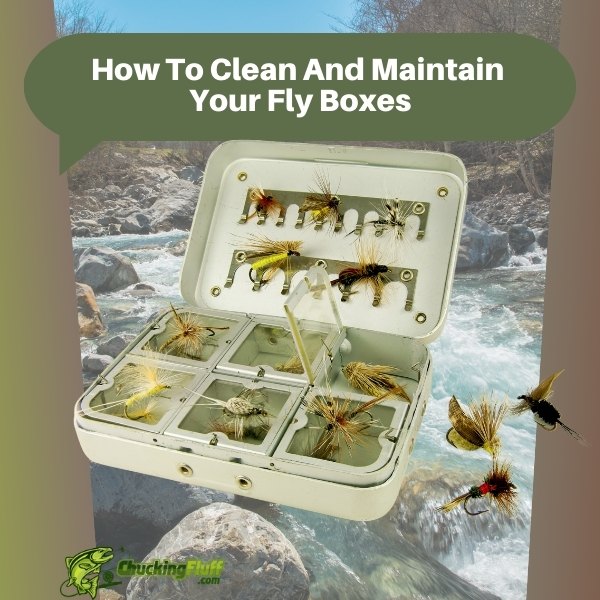| Disclosure: Just to be open and honest the buttons and links you click on in the website will in most cases take you to another website where you can purchase the products I am reviewing. As an Amazon Associate I earn from qualifying purchases. |
How To Clean And Maintain Your Fly Boxes – Avoid Mold
Quick Post Navigation
- Understanding Fly Box Types and Materials
- The Basics of Fly Box Cleaning
- Step-by-Step Fly Box Cleaning Process
- Best Practices for Long-Term Fly Box Care
- Special Considerations for Different Fly Box Types
- Advanced Tips for Fly Box Maintenance
- How to Organize Flies After Cleaning
- Benefits of Regular Fly Box Maintenance
- Conclusion
- FAQs
- “Check out some of our other Buying Guides”
Fly boxes are essential for every angler, not just as containers but as protectors of valuable flies, keeping them ready for action. Yet, as they experience exposure to water, dirt, and the elements, fly boxes can become cluttered, damp, and even moldy. That’s why learning how to clean and maintain your fly boxes is a critical part of keeping your gear in top shape. This guide will take you through every step to ensure your fly boxes last and stay as effective as possible.
Understanding Fly Box Types and Materials
Common Fly Box Materials
Fly boxes come in various materials, each requiring a slightly different maintenance approach. Plastic and silicone are popular because they’re lightweight and water-resistant. Aluminum boxes are durable and stylish but can be prone to rust if not properly cared for. Foam-lined boxes, used for securing flies, need special care, especially since foam can degrade over time.
How Material Impacts Maintenance
Materials like plastic and silicone are straightforward to clean but may degrade faster under extreme conditions, while aluminum boxes require more attention to prevent oxidation. Foam inserts, while effective for holding flies, can be a magnet for moisture, potentially leading to mold. Recognizing the material of your fly box can help tailor your cleaning strategy.
The Basics of Fly Box Cleaning
When to Clean Your Fly Box
Knowing when to clean is half the battle. After a few fishing trips or at least once a season, inspect your fly box. Frequent use, especially in damp conditions, can speed up the need for cleaning. Generally, if you notice debris, a foul smell, or signs of mold, it’s definitely time for a cleanup.
Pro Tip: Drying your flies thoroughly before putting them back into your fly box can help reduce the need for cleaning excessively. Carrying a small box like the ones diabetics find their blood strips in can be good for placing used flies on any particular day. Then when you get back to base put your flies out on some kitchen toweling and let them dry off before placing them back into your fly box.
Necessary Cleaning Supplies
Having the right supplies will make cleaning a breeze. Essential items include:
- Mild dish soap
- A small, soft brush (like a toothbrush)
- Clean cloths or paper towels
- Rubbing alcohol (for disinfection)
- Cotton swabs for tight spaces
Step-by-Step Fly Box Cleaning Process
Emptying and Organizing Flies
Start by taking all the flies out of the box. This is a good opportunity to sort through them, remove damaged flies, and organize them by type. Having a clear surface to place them on, like a soft towel, ensures none get lost.
Removing Dust, Dirt, and Debris
Using a soft brush, gently sweep out any dust or debris. Pay close attention to the slots, foam, and any crevices where dirt can accumulate. A small vacuum cleaner with a soft brush attachment can also be helpful for larger fly boxes.
Cleaning and Disinfecting the Box
Mix a small amount of mild soap with warm water. Dip a cloth into the mixture and wipe down the box thoroughly. For hard-to-reach areas, use a cotton swab dipped in the soapy solution. After cleaning, use a cloth dampened with water to remove any soap residue. Then, apply a small amount of rubbing alcohol to disinfect and ensure that any mold spores are removed.
Drying and Reassembling
Drying is essential to avoid mold. Wipe the box down with a dry cloth and let it air dry completely, especially if it has foam inserts. After drying, replace your flies, taking the time to place them back in an organized fashion.
Best Practices for Long-Term Fly Box Care
Avoiding Mold and Rust
Mold and rust are the enemies of any fly box. To prevent mold, always dry your fly box before storing it. If you fish in saltwater, rinsing both the box and flies with freshwater can prevent salt buildup, which causes rust. Using silica gel packets can also help absorb any lingering moisture.
Proper Storage Techniques
Store your fly box in a cool, dry place, ideally away from direct sunlight, which can cause materials to weaken over time. If you have multiple boxes, stack them loosely to promote air circulation.
Rotating Your Fly Collection
Rotating the flies in your collection can help prevent any single fly from becoming too damaged from moisture. Regularly inspect your flies and replace any that show wear or signs of rust.
Special Considerations for Different Fly Box Types
Waterproof Fly Boxes
Waterproof fly boxes can offer a bit of leeway with moisture but still benefit from a regular clean. These boxes can be submerged in soapy water if dirty, but always ensure they are completely dry before sealing to avoid trapped moisture.
Foam vs. Slotted Insert Boxes
Foam insert boxes tend to hold onto dirt and oils from flies. When cleaning foam, a gentle scrub with a soapy toothbrush is ideal. For slotted inserts, avoid using anything too abrasive that could damage the slots.
Advanced Tips for Fly Box Maintenance
Seasonal Deep Cleaning
Every season, it’s a good idea to do a deep clean. This involves taking out every fly, inspecting for any hidden dirt or mold, and disinfecting the entire box. Even a seasonal cleanup can prolong the lifespan of your gear.
Removing Stubborn Stains
For persistent stains, especially in plastic or silicone boxes, a small amount of baking soda mixed with water can create a gentle scrub. Apply with a soft cloth to remove stubborn marks without scratching the surface.
How to Organize Flies After Cleaning
Categorizing Flies by Type
Organizing flies based on type or season can make fishing much easier. For instance, keep your dry flies in one section, wet flies in another, and perhaps even label them for easy access.
Labeling and Tagging
Consider using small labels or tags inside your box to differentiate flies by season or species. This system can be especially useful if you have several boxes and want to grab the right one quickly.
Benefits of Regular Fly Box Maintenance
Improved Fly Longevity
Regular maintenance isn’t just about a clean box; it also prolongs the life of your flies. By removing dirt and preventing mold, you help keep each fly in optimal condition.
Reduced Wear and Tear on Flies
Without maintenance, flies can rub against debris in the box, damaging delicate feathers or hooks. Clean boxes reduce wear and tear, keeping your flies in fishing condition for longer.
Conclusion
Cleaning and maintaining your fly boxes might seem like a small task, but it’s crucial for any angler serious about preserving their gear. With regular maintenance, your flies will remain fresh, organized, and ready for every fishing adventure. From a quick wipe-down to a full seasonal scrub, each step contributes to the longevity of your gear, letting you focus more on the thrill of fishing than on gear upkeep.
FAQs
1. How often should I clean my fly box?
For the best results, aim for a thorough cleaning at least once a season or after several trips.
2. Can I use bleach to disinfect my fly box?
Avoid bleach as it can be too harsh for some materials. Rubbing alcohol is a safer alternative.
3. What’s the best way to dry a fly box?
Air drying is ideal. Make sure the box is completely dry before adding flies back in.
4. How can I prevent rust in my fly box?
Dry your box thoroughly after each use, especially if you’ve been fishing in saltwater, and consider adding a silica gel packet.
5. Do I need to clean waterproof fly boxes?
Yes! While they resist moisture, they can still accumulate dirt and grime, so a seasonal cleaning is beneficial.



